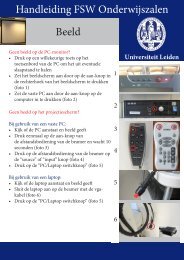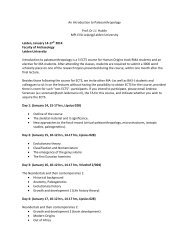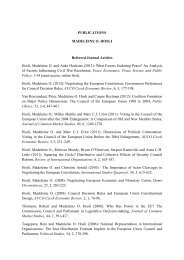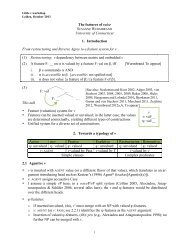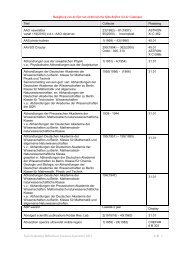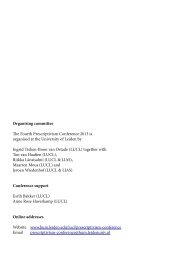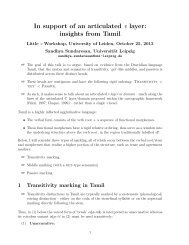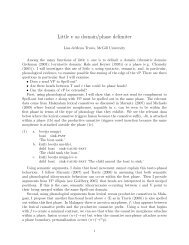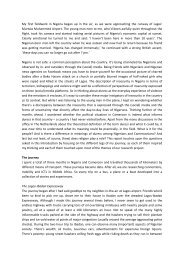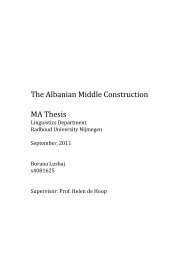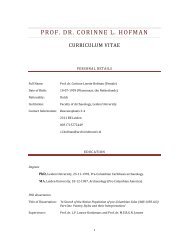Programme
Programme
Programme
Create successful ePaper yourself
Turn your PDF publications into a flip-book with our unique Google optimized e-Paper software.
On the Phonetics and Phonology of Stang's and Szemerényi's Laws<br />
Ryan Sandell, UCLA<br />
This paper works towards a better understanding of the phonetic and phonological processes<br />
in Proto-Indo-European that bear the labels of Stang’s Law (Stang 1965: 292 ff.) and<br />
Szemerényi’s Law (Szemerényi 1970: 106-11). Descriptively, both laws appear to involve the<br />
the loss of certain consonants in auslaut when preceded by certain other consonants, with<br />
consequent compensatory lengthening of the vowel in the final syllable (e.g., **di̯ eu̯ -m ><br />
*di̯ ēm; **ph 2 ter-s > *ph 2 tēr). Principally, two questions require an account:<br />
1. why are those certain word-final consonants lost?<br />
2. why does the loss of those consonants result in compensatory lengthening?<br />
Answers to the first question seem largely straightforward with respect to Stang's Law:<br />
assimilation of segments, coupled with the well-known constraint against adjacent identical<br />
segments in PIE, leads to loss of a consonant (cf. Mayrhofer 1986 [2012]: 171-2). In the case<br />
of Szemerényi's Law, already Szemerényi (1970: 109) advanced a similar explanation based<br />
on assimilation (e.g., *-rs#>*-rr#) and degemination, but some more recent work (e.g., Byrd<br />
2010: 88-94) has instead suggested that a general ban on word-final resonant + fricative<br />
sequences was operative in PIE. The fact that cases involving both *s and *h 2 , despite the<br />
divergent phonetic properties of those segments, have been adduced as instances of<br />
Szemerényi's Law (cf. Szemerényi 1970: 155, 159), raises the further question of whether the<br />
all Szemerényi's Law phenomena reflect the same process.<br />
The second question is more troubling, in light of the fact that a plausible model of<br />
compensatory lengthening (Moraic Theory; see Hayes 1989) does not predict compensatory<br />
lengthening of the type VC 1 C 2 # > V̄ C 1 #, and that the typological study of Kavitskaya (2002)<br />
does not find evidence for compensatory lengthening of such a type. Evidence from Greek,<br />
Latin, and Indo-Iranian, however, suggests that word-final consonants may have been<br />
extrametrical (i.e., did not bear a mora) in PIE (a not uncommon situation cross-linguistically;<br />
cf. Hayes 1995: 56-60). Thus, when a formerly weight-bearing consonant became word-final,<br />
its mora was transferred to the preceding vowel, and so produced the lengthened vowel.<br />
References:<br />
Byrd, A. M. (2010). Reconstructing Indo-European Syllabification. Ph.D. thesis, University<br />
of California, Los Angeles.<br />
Hayes, B. (1989). Compensatory Lengthening in Moraic Phonology. Linguistic Inquiry 20,<br />
253--306.<br />
Hayes, B. (1995). Metrical Stress Theory. Chicago: University of Chicago Press.<br />
Kavitskaya, D. (2002). Compensatory Lengthening: Phonetics, Phonology, Diachrony. New<br />
York: Routledge.<br />
Mayrhofer, M. (1986 [2012]). Indogermanische Grammatik I 2: Lautlehre. Heidelberg: Carl<br />
Winter.<br />
Stang, C. (1965). Indo-Européen *G w ŌM, *D(I)I̯ ĒM. In: Symbolae linguisticae in honorem<br />
Georgii Kuryłowicz (Polska Akademia Nauk. Prace Komisji Językoznawsta, ed.).<br />
Wrocław: Zakład Narodowy im. Ossolińskich.<br />
Szemerényi, O. (1970). Einführung in die vergleichende Sprachwissenschaft. Darmstadt:<br />
Wissenschaftliche Buchgesellschaft.<br />
36



